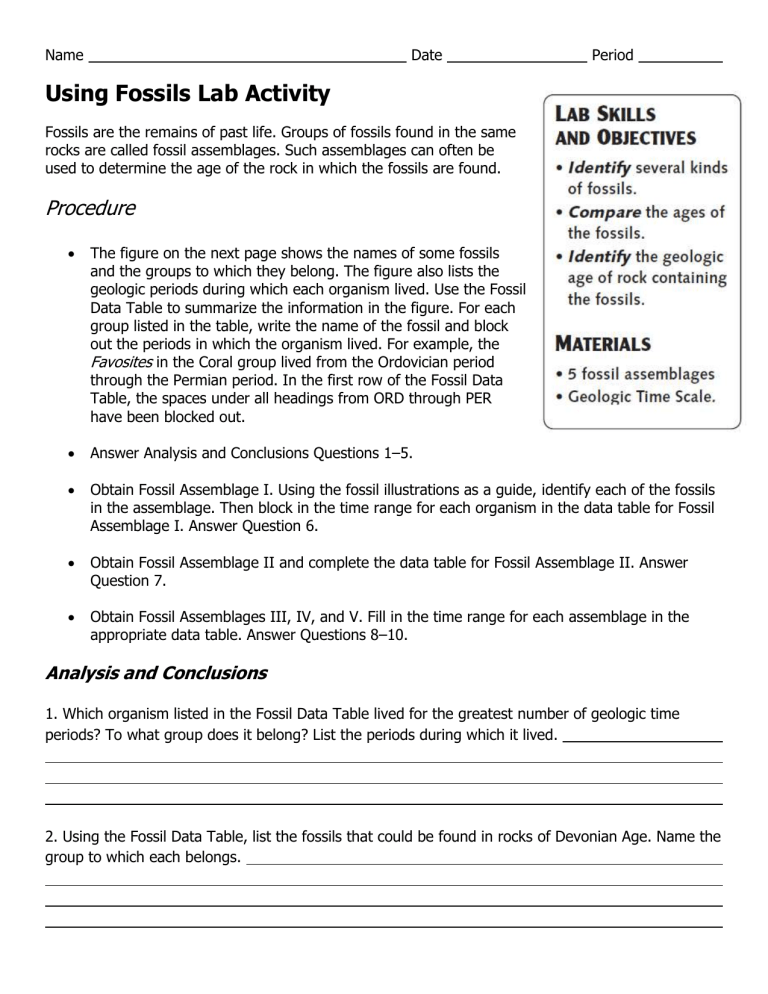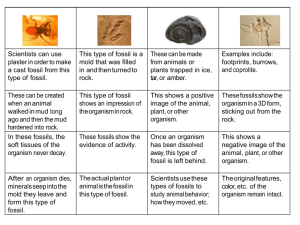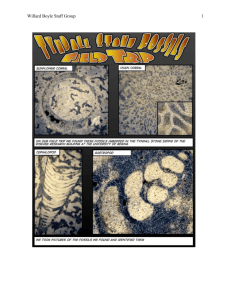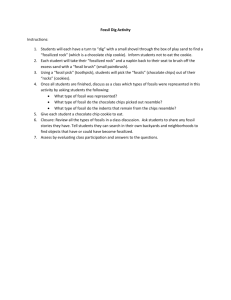Using Fossils Lab Activity

Name
Using Fossils Lab Activity
Date Period
Fossils are the remains of past life. Groups of fossils found in the same rocks are called fossil assemblages. Such assemblages can often be used to determine the age of the rock in which the fossils are found.
Procedure
The figure on the next page shows the names of some fossils and the groups to which they belong. The figure also lists the geologic periods during which each organism lived. Use the Fossil
Data Table to summarize the information in the figure. For each group listed in the table, write the name of the fossil and block out the periods in which the organism lived. For example, the
Favosites in the Coral group lived from the Ordovician period through the Permian period. In the first row of the Fossil Data
Table, the spaces under all headings from ORD through PER have been blocked out.
Answer Analysis and Conclusions Questions 1–5.
Obtain Fossil Assemblage I. Using the fossil illustrations as a guide, identify each of the fossils in the assemblage. Then block in the time range for each organism in the data table for Fossil
Assemblage I. Answer Question 6.
Obtain Fossil Assemblage II and complete the data table for Fossil Assemblage II. Answer
Question 7.
Obtain Fossil Assemblages III, IV, and V. Fill in the time range for each assemblage in the appropriate data table. Answer Questions 8–10.
Analysis and Conclusions
1. Which organism listed in the Fossil Data Table lived for the greatest number of geologic time periods? To what group does it belong? List the periods during which it lived.
2. Using the Fossil Data Table, list the fossils that could be found in rocks of Devonian Age. Name the group to which each belongs.
3. Using the Fossil Data Table, list the fossils that could be found in rocks of the Jurassic Period.
Name the group to which each belongs.
4. Could fossils of the trilobite Flexicalymene and the coral Favosites be found in the same rock layer?
Explain your answer.
5. Could fossils of the trilobite Phacops and the brachiopod Terebratula be found in the same rock layer? Explain your answer.
6. Use the data table for Fossil Assemblage I and the Geologic Time Scale of your text to identify the age of the rocks from which Fossil Assemblage I could have been obtained.
7. Identify the age of the rocks from which Fossil Assemblage II could have been obtained.
8. Identify the age of the rocks from which Fossil Assemblage III could have been obtained.
9. Identify the age of the rocks from which Fossil Assemblage IV could have been obtained.
10. Identify the age of the rocks from which Fossil Assemblage V could have been obtained.
Summary Questions
1. Are the fossils assemblages from this lab plant or animal? Based upon your answer do you believe these organisms were terrestrial or marine?
2. What can fossils tell us about their environments?
3. Based upon your answer to the previous two questions how do you think these fossils where formed?
4. Which type of rock formation would these fossils most likely be found?






